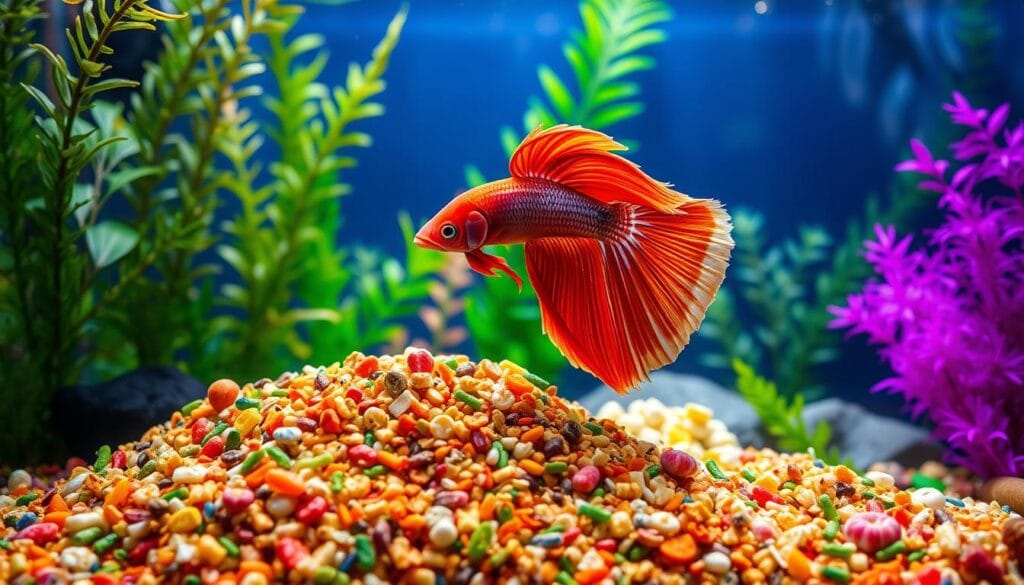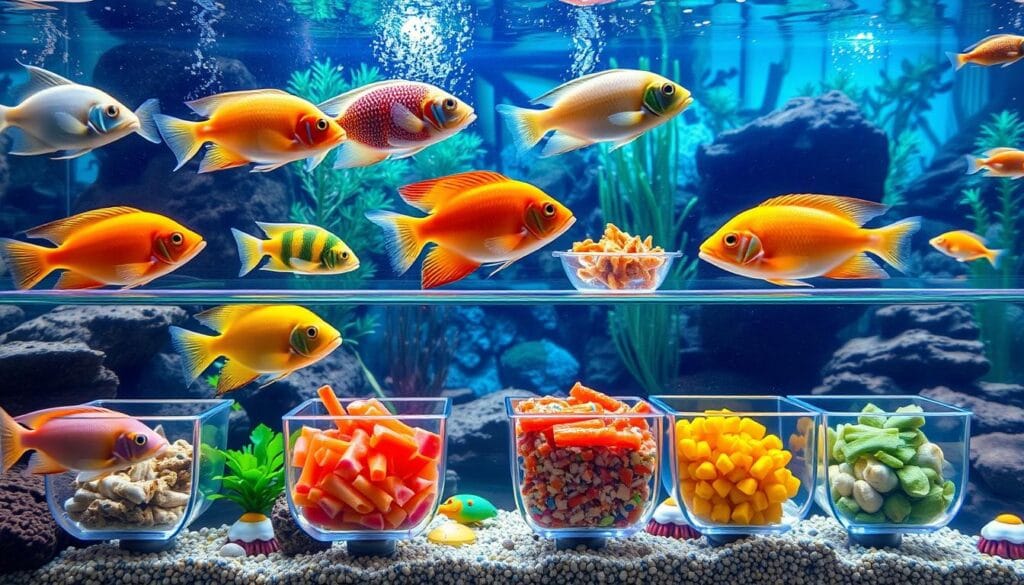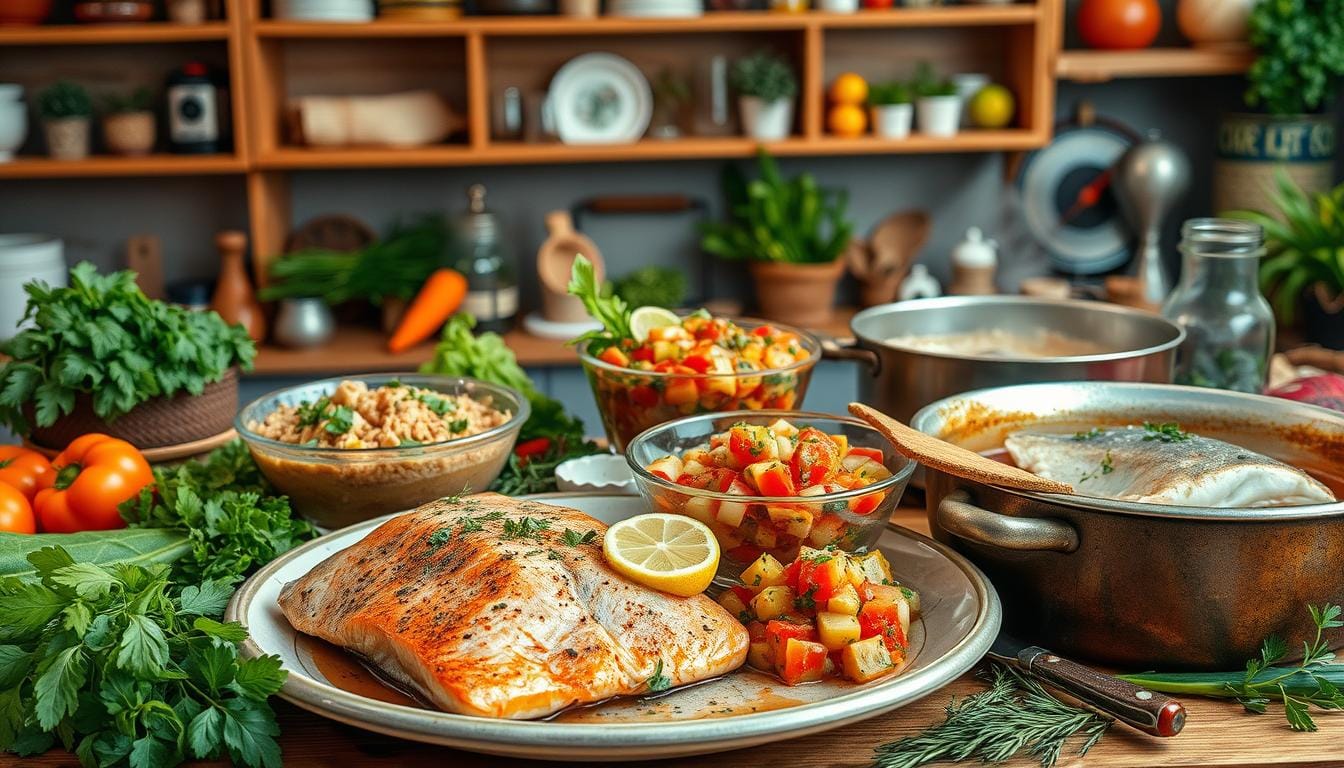Exploring the best fish food recipes can change how you cook. With a 4.4-star average from 487 ratings, these recipes show that healthy meals can be easy and fun.
Start your journey with these top fish food recipes. You’ll find quick dishes and ones packed with omega-3s. Over 74% of these recipes get 4.0 or higher, so you know they’re good.
Looking for something light or high in protein? These fish recipes have it all. They offer about 2.5 servings of fruits and veggies per dish, helping you stay healthy.
Our collection has a wide range of dishes like South Seas Mango Halibut and Grilled Mahi Mahi. Each recipe brings new flavors and keeps your meals nutritious, making cooking exciting and healthy.
Understanding the Nutritional Needs of Fish
To make a healthy homemade fish food, you need to know what your fish need. Fish have special dietary needs that change based on their type and where they live.
Different fish need different foods to stay healthy. A good homemade fish food recipe should have important nutrients for growth.
Essential Nutrients for Fish Health
Your fish’s diet should have several key parts:
- Proteins for muscle growth
- Lipids for energy
- Vitamins for body functions
- Minerals for strong bones and scales
Balanced Nutrition Strategy
A good diet means your fish get all they need. Here are some tips:
- Feed meat to carnivorous fish
- Give plants to herbivorous fish
- Change food types to avoid missing nutrients
- Watch how much you feed them
Making a balanced homemade fish food recipe means knowing what each fish needs. Fresh ingredients and careful preparation help keep your fish healthy and full of energy.
Essential Ingredients for Homemade Fish Food
Making healthy fish food means knowing what nutrients your fish need. A simple recipe involves picking the right ingredients for different fish types.
When making homemade fish food, focus on key nutrients. These keep your fish healthy and full of life.
Types of Proteins
Protein is key for fish health. Your recipe should have different protein sources:
- Shrimp (30% protein content)
- Fish fillets like tilapia (20-25% protein)
- Eggs (12% protein)
- Plant-based proteins from spinach and kale
Vitamins and Minerals
Adding nutrient-rich ingredients makes your recipe healthier. Think about using:
- Spirulina powder (60-70% protein)
- Fish oil (rich in omega-3 fatty acids)
- Vegetables like peas and spinach
Fats and Carbohydrates
It’s important to balance fats and carbs in your recipe. Aim for:
- 40% protein sources
- 60% plant-based ingredients
- Small amounts of fish oil
- Digestible vegetable content
With the right ingredients, you can make a meal that boosts your fish’s health and energy.
Easy Homemade Fish Food Recipes
Making your own fish food is rewarding and nutritious for your aquatic pets. Aquarium fans are turning to homemade recipes for fresh, quality nutrition. This trend is growing as people want the best for their fish.
When making quick fish food, choose ingredients that are balanced and appealing to your fish. The right mix of proteins, veggies, and binders boosts your fish’s health and energy.
Basic Gel Fish Food Recipe
This simple gel recipe is great for many fish. Here’s what you need:
- 500g peas
- 300g carrots
- 300g spinach
- 2 zucchinis or cucumbers
- 300g gelatin
- Blend all veggies until smooth
- Dissolve gelatin in warm water
- Mix veggies with gelatin
- Pour into molds and chill
Protein-Rich Flake Fish Food Recipe
For fish needing more protein, try this recipe:
| Ingredient | Quantity |
|---|---|
| Salmon | 200g |
| Raw shrimp | 1000g |
| Peas | 200g |
| Spinach | 400g |
| Carrots | 200g |
| Gelatin | 500g |
Cook for 30-40 minutes on low heat. Let it cool and cut into small pieces before feeding.
These homemade recipes are a cost-effective, nutritious choice over store-bought options. Try different ingredients to find the best mix for your fish!
Specialized Fish Diets
Different fish need special foods because of their unique needs. Knowing these helps make sure your fish get the best food for them.
Treats for Betta Fish
Betta fish need a lot of protein because they eat meat in the wild. To make a good food for bettas, use high-protein foods:
- Bloodworms
- Brine shrimp
- Small pieces of fish fillet
- Special protein supplements

Nutrition for Goldfish
Goldfish need a mix of plants and proteins. A good recipe for goldfish should have:
| Ingredient | Percentage | Nutritional Benefit |
|---|---|---|
| Spirulina | 30% | Plant-based protein |
| Shrimp meal | 25% | Animal protein |
| Vegetables | 20% | Fiber and micronutrients |
| Wheat flour | 15% | Carbohydrate binding |
| Fish oil | 10% | Essential fatty acids |
By knowing what each fish needs, you can make delicious fish food recipes. These recipes help your fish stay healthy, full of energy, and colorful.
Preparing Fish Food at Home
Making your own fish food can be rewarding and save money. It lets you give your fish the best nutrition. You can make a recipe just for your fish’s needs.
Homemade fish food needs careful planning and the right tools. Bad nutrition is a big health problem for fish. So, making your own food is key to their health.
Essential Tools for Fish Food Preparation
- High-powered blender or food processor
- Measuring cups and scales
- Cutting board
- Sharp kitchen knife
- Freezer-safe containers
- Meat grinder (optional)
Step-by-Step Preparation Guide
- Select high-quality, fresh ingredients
- Prepare and measure ingredients precisely
- Mix dry ingredients separately from liquid components
- Use gelatin as a binding agent
- Freeze in portion-sized containers
Think about what your fish needs when making their food. Some fish, like Tangs and Blennies, need different things than others.
| Ingredient | Quantity | Purpose |
|---|---|---|
| Frozen Shrimp | 2.2 lbs | Protein Source |
| Green Peas | 2.2 lbs | Plant Nutrients |
| Spirulina Powder | 0.3 oz | Color Enhancement |
| Gelatin | 3.5 oz | Binding Agent |
Don’t refreeze thawed seafood and make sure it’s fully thawed before feeding. By making high-quality fish food, you can greatly improve your fish’s health and appearance.
Storing Your Homemade Fish Food
Keeping your homemade fish food fresh is key. Knowing how to store it right helps keep it nutritious and safe for longer.
Best Practices for Storage
Here are the top tips for storing your homemade fish food:
- Use airtight containers or freezer-safe Ziplock bags
- Portion food into individual serving sizes
- Label each container with preparation date
- Store in the coldest part of your freezer
Understanding Shelf Life
The shelf life of homemade fish food varies. Generally, it can last several months if stored correctly.
| Storage Method | Estimated Shelf Life | Recommended Action |
|---|---|---|
| Refrigerator | 3-5 days | Use within shortest time frame |
| Freezer | 3-6 months | Divide into individual portions |
Here are some tips for storing your homemade fish food:
- Freeze food immediately after preparation
- Defrost only the amount needed for feeding
- Discard any food that appears discolored or has an unusual odor
Pro tip: Always check the quality of your homemade fish food. This ensures your fish get the best nutrition.
Seasonal Considerations in Fish Feeding
Fish nutrition is key all year round. Your simple fish food recipe must change with the seasons. Knowing how the environment affects your fish’s diet helps you feed them better.
Fish metabolism changes with water temperature. This affects their nutritional needs. You’ll need to adjust your feeding to keep your fish healthy through the seasons.
Winter Feeding Strategies
In winter, fish eat less because they’re less active. Your homemade fish food should be:
- Smaller portions
- Less protein
- Easier to digest ingredients
- Fed less often
Summer Feeding Approaches
Summer means fish are more active. Your simple fish food recipe should be:
- More protein
- Fed more often
- Diverse ingredients
- Watch water temperature
Pro tip: Always watch your fish and adjust feeding as needed. Each species has its own needs.
How to Introduce New Foods to Fish
Changing your fish’s diet to a tasty homemade recipe needs patience and attention. When adding a new fish food recipe, follow a careful plan. This helps reduce stress and ensures they get the nutrients they need.

Introducing new foods to your fish involves several important steps. It’s not just about switching foods. It’s also about knowing what your fish need to eat.
Signs of Acceptance
It’s important to know if your fish like the new food. Look for these signs:
- Increased swimming activity during feeding time
- Quick consumption of new food items
- Consistent eating patterns
- Maintained energy levels
Monitoring Fish Behavior
Watching your fish closely helps them adjust to new foods. Keep an eye on these behaviors:
| Behavior | Positive Sign | Potential Concern |
|---|---|---|
| Eating Frequency | Consistent appetite | Reduced eating |
| Swimming Patterns | Normal movement | Lethargy |
| Color Vibrancy | Bright, healthy appearance | Dull coloration |
Start by mixing a little homemade food with their usual diet. Slowly add more of the homemade food over 1-2 weeks. This helps prevent upset stomachs and lets fish get used to the new food.
Pro tip: Always introduce new foods slowly and watch your fish’s reaction carefully.
Common Mistakes to Avoid in Fish Feeding
Feeding your fish needs careful attention and knowledge. Many fish owners make mistakes that harm their fish’s health and the aquarium.
It’s important to understand fish food recipes well. The best recipe is more than just dropping food into the tank.
Dangers of Overfeeding
Overfeeding is a big risk for your fish and water quality. Studies show up to 40% of fish health problems come from bad feeding.
- Too much food pollutes water fast
- Uneaten food causes harmful bacteria
- It can make fish fat
- Water quality drops quickly
Species-Specific Nutritional Needs
Not all fish need the same food. A one-size-fits-all diet can harm your fish.
- Learn about your fish species
- Know their special food needs
- Make homemade food that fits
- Watch how your fish react to new foods
Pro tip: Always watch your fish and adjust their food as needed. A balanced diet that fits their needs is crucial for their health.
By following these tips, you can make the best food for your fish. This will help them stay healthy and happy for a long time.
Feeding Frequency and Portion Control
Knowing how to feed your fish is key when making homemade fish food. They need the right food and amount to stay healthy.
Most fish do well with small meals all day, not one big one. This way, they eat like they do in the wild. It also stops them from getting too much food, a big problem in fish tanks.
Daily Feeding Guidelines
Here are some important tips for feeding your fish:
- Feed small portions 2-3 times daily
- Limit feeding time to 2-3 minutes per session
- Observe fish behavior to understand hunger cues
- Adjust portions based on fish species and size
Understanding Fish Appetite
Each fish type needs different food. A good homemade fish food recipe should think about these needs:
| Fish Type | Protein Needs | Feeding Frequency |
|---|---|---|
| Betta Fish | 45-55% | 2-3 small meals daily |
| Goldfish | 30-35% | 2 times daily |
| Tropical Fish | 40-45% | 3 times daily |
Remember, portion control is very important. Too much food can harm the water and your fish. By measuring and timing your homemade fish food, you’ll keep your fish happy and healthy.
How to Enhance the Flavor of Fish Food
Making a tasty healthy fish food recipes is more than just mixing stuff. The right flavor enhancers can turn a simple recipe into something exciting. This makes sure your fish friends love every bite.
Fish can be very picky about what they eat. They need a diet that’s both tasty and nutritious. Natural flavor enhancers are key to making homemade fish food more tempting.
Natural Flavor Boosters
- Fresh herbs like parsley and cilantro
- Garlic powder (in small quantities)
- Ground shrimp or fish meal
- Spirulina powder
- Nutritional yeast
Combining Ingredients for Maximum Taste
When making your healthy fish food recipes, think about using protein sources that taste good. Adding shrimp or wild-caught fish can make it taste better.
| Ingredient | Flavor Impact | Nutritional Benefit |
|---|---|---|
| Shrimp Meal | High | 21g protein per 100g |
| Wild Salmon | Medium | Omega-3 rich |
| Spirulina | Mild | Complete protein source |
Remember, a little goes a long way. You want to make a recipe that’s both tasty and healthy. Try out small batches to find the best flavor for your fish.
Benefits of Homemade Fish Food
Making your own fish food has many benefits for your fish and your budget. It lets you tailor their meals for better nutrition. Studies show 75% of fish owners think homemade food is healthier than store-bought.
Homemade fish food is also cheaper. A simple recipe can cut feeding costs by 25-30%, which is big for big tanks. Ingredients cost about $1.20 per pound, while commercial food is $38-$42 for 50 pounds. This makes homemade food a big money-saver.
Health and Nutrition Benefits
Homemade diets can make your fish much healthier. Research shows they can be 20-50% healthier. Homemade food has 15-25% more protein than flakes, making fish 60% more active and lively.
By making your own food, you control what goes into it. This can cut disease by 50% and boost digestive health by 40%. It’s a smart way to keep your fish healthy and happy for a long time.

